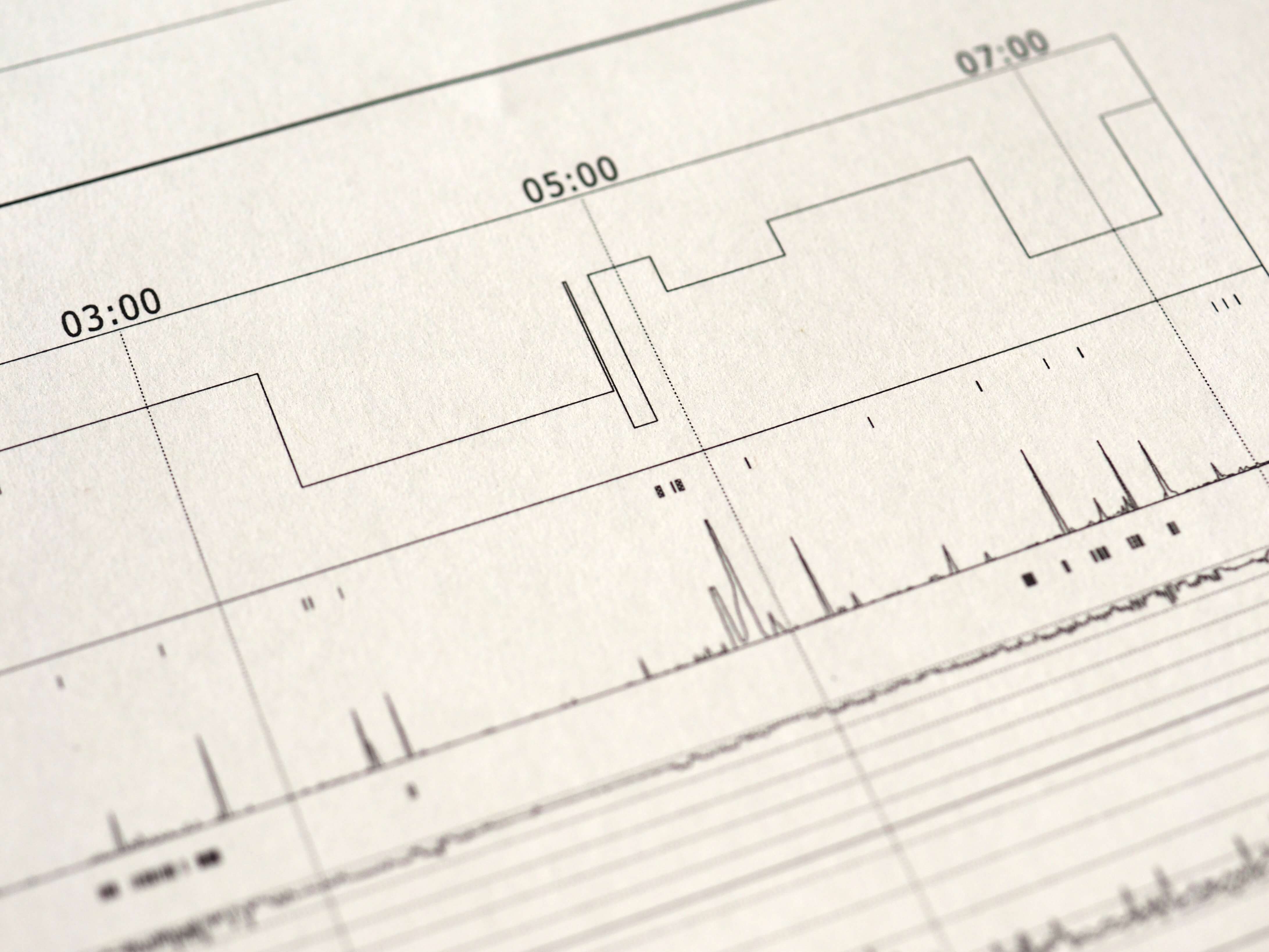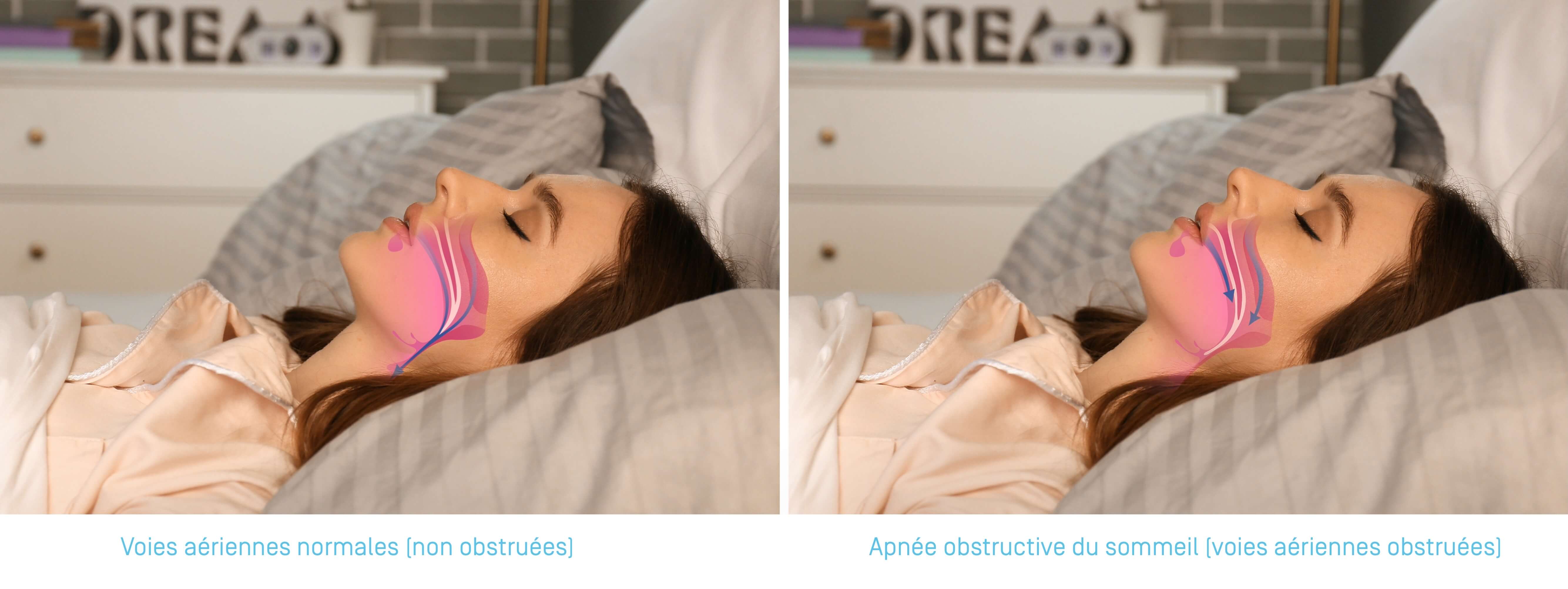Obstructive sleep apnea (OSA), the most common form, is caused by a relaxation of the soft tissues of the throat (tongue and palate), blocking the airway. People with OSA may wake up briefly to catch their breath. These awakenings, although often unconscious, disrupt their sleep. Early detection can improve sleep quality and prevent complications.
Risk factors
Several factors increase the risk of developing OSA, including :
- Overweight or obesity: excess fatty tissue around the neck can compress the airways.
- Age: OSA is more common in people over 50.
- Gender: men are more at risk than women, although the risk increases in women after the menopause.
- Airway anatomy: an enlarged tongue, enlarged tonsils or recessed chin can contribute to airway obstruction.
What are the symptoms of sleep apnea?
Symptoms of sleep apnea vary, but tend to occur during both sleep and wakefulness. The main indicators to watch out for are as follows:
At night:
- Loud, chronic snoring, often observed by bed partner
- Breathing pauses detected by the bed partner
- Frequent awakenings with a feeling of suffocation
- Non-restorative, restless sleep
Daytime:
- Fatigue and excessive sleepiness, even after what appears to be a full night's sleep
- Dry mouth or sore throat on waking, often due to mouth breathing
- Morning headaches resulting from lack of oxygen during the night
- Difficulty concentrating, irritability or depression
If you or someone you know has one or more of these symptoms, consult a GP or your GP, as untreated sleep apnea can have long-term consequences.
How is sleep apnea diagnosed?
Doctors begin by taking the patient's history, as well as any nocturnal or diurnal symptoms compatible with the diagnosis of OSA. During the clinical examination, they look for factors predisposing to sleep apnea. Diagnosis is then based on two types of examination:
Polysomnography: this is the reference test performed at Hôpital de La Tour or in a sleep laboratory. It measures various sleep parameters, such as brain activity, heart rate, respiratory movements and blood oxygen levels.
Home tests: portable devices can measure certain respiratory parameters in selected patients.

The choice of type of examination, as well as the advantages and disadvantages of each, can be discussed with your doctor at your first appointment.
How is sleep apnea treated?
There are several options for treating sleep apnea, depending on its severity and the patient's state of health.
Adapt your lifestyle
- Overweight and obesity: if OSA is linked to excess weight, weight loss can often reduce or even eliminate sleep apnea. Excess adipose tissue around the neck can obstruct the airways.
- Sleeping position: sleeping on your back can aggravate apneas. Sleeping sideways can be beneficial, improving sleep quality. When apneas are highly dependent on sleep position, patients can be encouraged to sleep on their side with the aid of a device.
- Alcohol and sedatives: these substances relax the throat muscles, making apneas worse. Smoking should also be avoided.
Orthodontic braces
These night-worn braces help keep the airways open by advancing the jaw or preventing the tongue from blocking the throat. They are particularly useful for people with mild to moderate apnea who are not overweight.
CPAP therapy
Continuous Positive Airway Pressure (CPAP) is the standard treatment for OSA. A device blows air through a mask worn over the nose and/or mouth to keep the airways open during sleep. This is the most effective treatment for snoring and sleep apnea. It does, however, require some getting used to the breathing apparatus.
Hypoglossal nerve stimulation: an innovative alternative for treating sleep apnea
Hypoglossal nerve stimulation is an advanced technology that keeps the airway open during sleep by sending targeted electrical impulses to the tongue muscles. This method is an effective alternative for patients suffering from moderate to severe obstructive sleep apnea, when CPAP therapy is unsuitable or ineffective. A device consisting of a generator is implanted under the skin, together with a breathing sensor and a stimulation electrode. Thanks to an intelligent algorithm, it detects inhalation and exhalation phases to stimulate the hypoglossal nerve at critical moments, thus preventing sleep apnea.
Learn more about Gilles' experience:
The system is implanted under anaesthetic during a short hospital stay. After the procedure, an adjustment phase enables the settings to be optimized for each patient, guaranteeing greater treatment efficacy. This device significantly improves sleep quality and reduces apnea symptoms, offering a promising alternative for people unable to use CPAP.
Surgical intervention
In some cases, surgery may be considered, including removal of the tonsils (tonsillectomy), or interventions to reposition the jaw. However, surgery is generally reserved for patients who cannot tolerate CPAP.
These treatment options are chosen according to the specific characteristics of each patient and the underlying cause of apnea. CPAP remains the reference treatment for the majority of cases of OSA.
What are the possible complications?
Left untreated, sleep apnea can lead to adverse health consequences, such as:
- High blood pressure: OSA is associated with high blood pressure and can make hypertension more difficult to control with medication.
- Heart disease: OSA is associated with cardiovascular risk (myocardial ischemia, heart rhythm disorders and stroke).
- Diabetes: OSA is often associated with insulin resistance.
- Road accidents: due to excessive daytime sleepiness, the risk of accidents is considerably increased. A positive answer to the question “I feel drowsy at the wheel” already considerably increases the risk of road accidents.
Important facts
Sleep apnea syndrome is treatable. Certain symptoms suggestive of OSA, such as snoring, unrefreshing sleep or daytime sleepiness, may justify a medical consultation with your GP, who will decide whether a diagnostic examination and specialized consultation are necessary. CPAP, mandibular advancement orthoses and, in some cases, surgery are effective treatment options. Appropriate treatment can restore better quality sleep and improve your quality of life.
